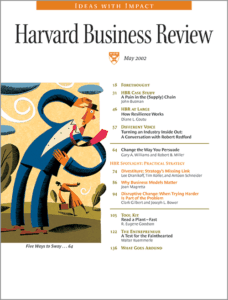Mark's note: I somehow stumbled across this 2002 HBR article, Read a Plant–Fast, so I asked regular guest blogger Paul Critchley to write a post about it and his thoughts.
Personally, I think it's fair to refer to Lean transformations as a journey. For those of us who have undertaken the charge, we can attest to the authenticity of this statement. Overcoming years (sometimes decades) of preconceived notions and learned behavior is no small task. Successful, sustainable change happens over time by making small improvements often (Kaizen) and reinforcing the behaviors that allow them to occur (Respect for People).
As a Lean practitioner, I've seen my fair share of Lean initiatives wither and die. This can happen for many different reasons, and none of them are good. Often, though, Lean failure can be traced back to something going wrong with the culture piece of the puzzle. By design, the Lean tools aren't overly complicated, and most of the places I've been seem to understand and acknowledge their usefulness pretty quickly. However, the culture side of the coin is notably more difficult to put into practice…
 This significant difference came to mind as I reviewed the article “Read a Plant – Fast.”
This significant difference came to mind as I reviewed the article “Read a Plant – Fast.”
In this article, the author breaks down his approach for how to read and rate the “Leanness” of a plant within about 30 minutes. He summarily breaks down, piece by piece, how to go about “reading” the plant, and offers two separate assessment tools to aid in the quick categorization thereof.
Now, in his defense, the tool was developed as an aid in business acquisition, not as a tool to help develop a Lean path.
I also applaud him for encouraging people to go to the Gemba to review a plant's health versus simply looking at balance sheets and income statements.
However, I take umbrage to the notion that anyone can spend 30 minutes in a manufacturing plant and get an accurate idea of how “Lean” it truly is. At best, this is a snapshot in time only, and I'd argue that even that is not indicative of the overall intention of the organization when it comes to Lean.
When I was working in industry, my employer had their own branded version of Lean; let's call it the Company Business System (CBS). This system had a similar ranking scale as the tools in the article above, and based upon your overall score, you were deemed to be CBS Bronze, Silver or Gold.
One afternoon, an executive I'd never seen in four years on the job showed up at one of our assembly manufacturing cells (on a chauffeured motorized cart, no less), took a look around and proclaimed with grandeur that we were a “Gold cell.”
Never mind that he hadn't looked at our visual management boards, had no idea how we dealt with product flow nor what kind of issues we were having. He formed an opinion based upon the fact that the area was clean and well lit. Had he asked, he'd have learned that the area was as clean (and empty) as it was because we were out of work waiting for supplier parts to be delivered (which were three weeks late and counting).
After he left, we all just looked at each other, shrugged our shoulders and kept doing what we were doing.
In my consulting firm, we use a tool very similar to the one the author outlines, but we'll typically spend at least a week doing an assessment, and, even, then our findings are limited to what we've seen during that period. I'll admit that we usually aren't very far off from actuals, but when we present our findings, we're always careful to mention that it's only represented by the data that we assessed during the time that we had, and it's relative, not absolute.
Perhaps this is just the way it goes. Progression being what it is, it's only natural that what once took days should now only take minutes – heck, that's part of Lean, right? Taking out waste to be more efficient and deliver more value? In our “I want it right now” society, it's easy to understand how and why folks would want to be able to make this determination more quickly. However, I don't think this approach gives you an accurate Lean representation, since it doesn't allow for the time it takes to really analyze the culture and relative respect for people.
It reminds me of this quote that appeared in an article on that Mark blogged about a few years ago:
“Toyota's showing the opposition how it makes cars is a bit like Coke's giving Pepsi a peek at its secret syrup formula. The Toyota Production System on display at Georgetown applies not just to manufacturing but also to almost everything Toyota does, from product development to supplier relations and distribution. But Toyota officials don't mind. Deep down, they know that the TPS techniques that visitors see on their tours – the kanban cards, andon cords, and quality circles-represent the surface of TPS but not its soul. Toyota isn't worried about giving away any important secrets on a plant tour.”
So, can you really gage an organization's Lean achievements in a 30-, 60- or even 90-minute tour, or are you simply assessing the success of Lean tool implementation?
Again, the author does advocate talking with the folks who do the work (which I'm in complete agreement with), but to truly get an accurate assessment, you have to spend the time and understand the culture. Does it celebrate failures when done under the umbrella of Kaizen, or does it shun such behavior? Do operators feel empowered to improve their jobs and work area, or are there layers of approvals needed before any change can happen?
My advice: be careful with such things. They do help to quantify – to represent via data – but that's only a piece of the whole. Don't ignore the other, less tangible part just because it takes time. True Lean transformation can only occur when both Continuous Improvement and Respect for People are represented.
Please scroll down (or click) to post a comment. Connect with me on LinkedIn.
Let’s work together to build a culture of continuous improvement and psychological safety. If you're a leader looking to create lasting change—not just projects—I help organizations:
- Engage people at all levels in sustainable improvement
- Shift from fear of mistakes to learning from them
- Apply Lean thinking in practical, people-centered ways
Interested in coaching or a keynote talk? Let’s start a conversation.










Very good points, and you are correct that a short tour is not an adequate gauge of a company’s development. Further, most companies prep for your arrival for at least a couple days before your tour. Some things though, are hard to hide and you can look for evidence in the small details. If you see a freshly swept floor, but no evidence of brooms, that’s one sign. If you see brooms, but no place to hang them, that’s another…empty racks tell you one thing, burgeoning racks indicate something else. No trash cans is bad; too many is worse – it indicates the approach to problem solving. If you are able to structure your tour as a reverse value stream walk (from shipping dock to front office), you can get a good read on facility flow and how well your guide understands that flow is good information. I read the HBR article some years ago and I would say it has some good things to look for.
Well, if you know how Gemba works – really – I think you laugh at a 30-90 minute observation period. As a Benchmarking professional, you are describing what I refer to as “Corporate Tourism” which is seeing a lot and learning nothing. The goal of Gemba (as I understand it) is actually understanding. Not saying it can’t be done in 90 minutes, but I’d prefer a lot longer…You know – like the amount of time the staff have spent observing their own work. Say 900 days…
Additional comment: But let’s be honest. If in 30 minutes, you see no visual performance indicators, the place is a mess, no work cells, constant motion and transportation, piles of inventory, no kanbans…yeah – not very Lean.